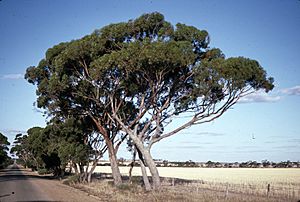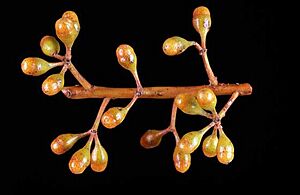Welcome Hill gum facts for kids
Quick facts for kids Welcome Hill gum |
|
|---|---|
 |
|
| Eucalyptus aequioperta near Hyden | |
| Scientific classification | |
| Genus: |
Eucalyptus
|
| Species: |
aequioperta
|
The Welcome Hill gum (scientific name: Eucalyptus aequioperta) is a special type of eucalyptus plant that grows mostly as a shrub with many stems, but sometimes it can grow into a small tree. It is found only in Western Australia, meaning it's endemic to that area. This unique plant has rough bark on the bottom part of its trunk, long, narrow leaves, and pretty white flowers that grow in groups. Its fruit looks a bit like a small cup.
Contents
What Does the Welcome Hill Gum Look Like?
The Welcome Hill gum usually grows as a mallee, which means it's a shrub with many stems coming from the ground. It can reach a height of about 5 to 8 meters (16 to 26 feet). Sometimes, it even grows into a small tree. This plant has a special woody swelling at its base called a lignotuber, which helps it regrow after fires.
Bark and Leaves
The bark on the lower part of the trunk and larger branches is dark grey. It feels firm and can be flaky or stringy. On older trees, the bark might look a bit like a checkerboard pattern. Higher up on the branches, the bark is smooth, dull, and can be pinkish-grey or white.
The adult leaves are shiny and green on both sides. They are shaped like a spear, or sometimes long and narrow, measuring about 60 to 110 millimeters (2.4 to 4.3 inches) long and 6 to 12 millimeters (0.2 to 0.5 inches) wide. Each leaf has a stem, called a petiole, which is about 8 to 17 millimeters (0.3 to 0.7 inches) long.
Flowers and Fruit
The flower buds of the Welcome Hill gum grow in groups of 7 to 15. These groups are found where the leaves meet the stem. Each group of buds sits on a small stalk, called a peduncle, which is about 5 to 15 millimeters (0.2 to 0.6 inches) long. The individual buds also have tiny stems, called pedicels, about 2 to 5 millimeters (0.08 to 0.2 inches) long.
The buds themselves are shaped like an "egg in an egg cup" or like a spindle. They are about 5 to 7 millimeters (0.2 to 0.3 inches) long and 2.5 to 3.5 millimeters (0.1 to 0.14 inches) wide. The top part of the bud, called the operculum, is like a cap that falls off when the flower opens. It's about 1.5 to 3 millimeters (0.06 to 0.12 inches) long. The flowers have white stamens, which are the parts that produce pollen.
Welcome Hill gum flowers have been seen blooming in May. After flowering, the plant produces fruit that is shaped like a cup or a cone, wider at the top and narrower at the base. These fruits are about 4 to 5 millimeters (0.16 to 0.2 inches) long and 5 to 6 millimeters (0.2 to 0.24 inches) wide.
How Was it Named?
The Welcome Hill gum was officially described for the first time in 1993 by two botanists, Ian Brooker and Stephen Hopper. They wrote about it in a science journal called Nuytsia. The first plant specimen used to describe the species was collected by Brooker in 1985 near Mount Walker, which is north of Hyden.
The scientific name aequioperta was chosen by Brooker and Hopper. They said it means "equal cover." However, another expert, Francis Sharr, mentioned that the exact meaning of the name isn't completely clear.
Where Does it Grow?
The Welcome Hill gum grows in red sand, often on sandhills. You can find it in several biogeographic regions of Western Australia, including the Avon Wheatbelt, Coolgardie, and Mallee areas. Its known range stretches from Corrigin in the west to Southern Cross and Coolgardie in the east. Scientists think it might even grow further east than what is currently known.
Is it Protected?
The Western Australian Government's Department of Parks and Wildlife has classified this eucalyptus as "not threatened." This means it's not currently considered to be in danger of disappearing.


